Afternoon shadows shed new light on iconic 'VJ Day Kiss' photograph
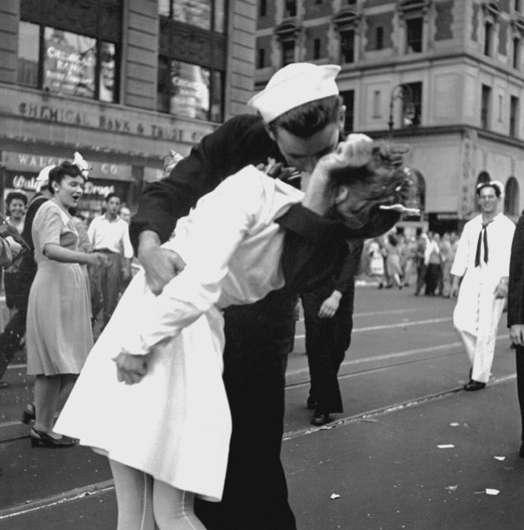
It is, perhaps, the most iconic kiss in American history—a U.S. sailor and a woman in white impulsively locking lips in New York City's Times Square to celebrate Japan's surrender and the end of World War II Aug. 14, 1945.
Famed Life magazine photographer Alfred Eisenstaedt captured that moment as he covered the growing celebration that lasted long into the night. Since its publication, though, the VJ Day Kiss has generated its share of controversy: Who is the sailor? Who is the woman in white? Establishing the identities is difficult, because their faces are largely obscured. And when was the photo actually taken? Establishing a precise time for the photo has a significant impact on which potential candidates could be the people in the photo—and which couldn't.
Now, for the 70th anniversary of the end of World War II, a team of astronomers from Texas State University has applied its unique brand of celestial sleuthing to that famous kiss. Their results shed new light on the timing of the photo, showing the kiss happened at precisely 5:51 p.m.
Texas State physics faculty members Donald Olson and Russell Doescher, along with Iowa State University astrophysicist Steven D. Kawaler, publish their findings in the August 2015 edition of Sky & Telescope, on newsstands now.
Dance of the Hours
Over the years, dozens of men and women have come forward claiming to be the persons in the photograph. All have different stories, but the one thing they share in common is kissing a stranger in Times Square that fateful day.
"All those people have said they were there and identify themselves in the photograph," Olson said. "Who's telling the truth? They all could be telling the truth about kissing someone. They were probably all there, and kisses were common in Times Square on VJ Day.
"I can tell you some things about the picture, and I can rule some people out based on the time of day," he said. "We can show that some of the accounts are entirely inconsistent with the astronomical evidence."
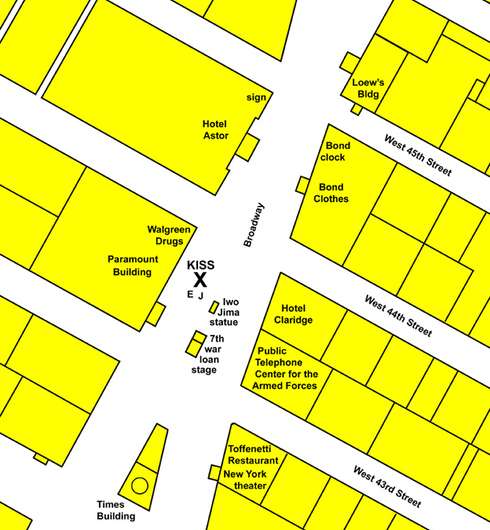
For decades, it was assumed the photo was taken after, perhaps just seconds after, President Harry S. Truman announced Japan's surrender. The announcement from the White House appeared on the electric sign in Times Square at 7:03 p.m. In 2010, however, Gloria Bullard, who identified herself in the background of the photo, gave an account of witnessing the kiss that placed the time closer to 6 p.m. The 2012 book, The Kissing Sailor by Lawrence Verria and George Galdorisi, places the time much earlier, near 2 p.m.
The Late Lunch
The 2 p.m. time cited by The Kissing Sailor is part of a timeline based on the accounts of George Mendonsa and Greta Zimmer, who are identified in the book as the kissing pair. According to the book's authors, Mendonsa attended Radio City Music Hall for a 1:05 p.m. movie, which was interrupted after only a few scenes when theatre employees announced the rumor of the impending Japanese surrender. Mendonsa rushed outside and soon found his way to Times Square, where he encountered Zimmer for the kiss around 2 p.m.
Zimmer, for her part, was on a late lunch break from her job as a dental assistant. Upon returning back to the office, the doctors told her to cancel all remaining appointments for that afternoon in anticipation of the looming celebration.
Clocks and Shadows
Overlooked in the right hand background of the photo is the Bond Clothes clock. The minute hand of this clock is clear, but the oblique angle of view and the clock's unusually short hour hand makes a definitive reading of the time difficult. The clock might show a time near 4:50, 5:50, or 6:50 p.m. A prominent shadow falls across the Loew's Building just beyond the clock, however, and this shadow could potentially give just as accurate a time reading as the clock.
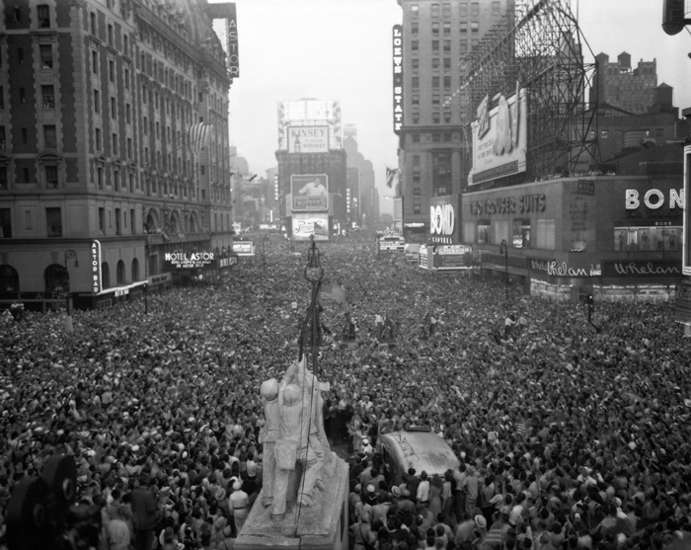
Every tall building in Manhattan acts as a sundial, its cast shadow moving predictably as the sun traverses the sky. In this case, the Texas State team studied hundreds of photographs and maps from the 1940s to identify the source of the shadow, considering, in turn, the Paramount Building, the Hotel Lincoln and the Times Building. The breakthrough came when a photograph of the Astor Hotel revealed a large sign shaped like an inverted L that advertised the Astor Roof garden.
Calculations showed that only the Astor Roof sign could have cast the shadow, but to be certain, Olson and Doescher built a scale model of the Times Square buildings with a mirror to project the sun's rays. The location, size and shape of the shadow on the model exactly matched the shadow in Eisenstaedt's kiss photographs.
Mistaken Identity?
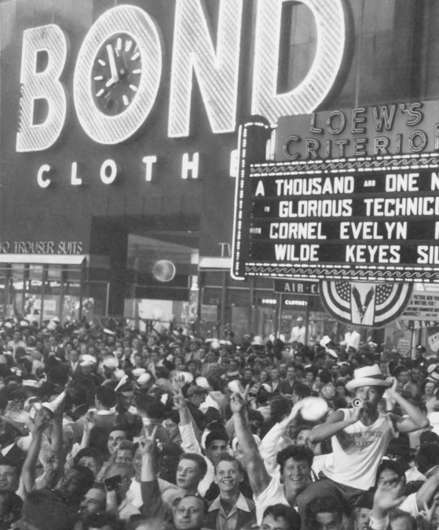
So who is the sailor? Who is the woman in white? Despite the new understanding of the photograph, those questions remain up for debate.
"The widely-accepted scenario of The Kissing Sailor book, with George Mendonsa kissing Greta Zimmer near 2 p.m., is ruled out by the astronomical analysis," Olson said. "Greta Zimmer's account states that she was on her late lunch hour, starting at 1 p.m., and after the kiss she returned to the office and the dentists told her to cancel the afternoon appointments. That's not going to happen after 6 p.m. Those details of her account are entirely inconsistent with the sunlight and shadows which show that the photographed kiss happened at 5:51 p.m. If George Mendonsa is the kissing sailor, then he didn't go to the 1:05 p.m. movie—he went to Radio City for the 4:07 p.m. showing.
"Astronomy alone can't positively identify the participants, but we can tell you the precise moment of the photograph," Olson said. "Some of the accounts are inconsistent with the astronomical evidence, and we can rule people out based on the position of the sun. The shadows were the key to unlocking some of the secrets of the iconic VJ Day images—we know when the famous kiss happened, and that gives us some idea of who might or might not have been in the picture."
-
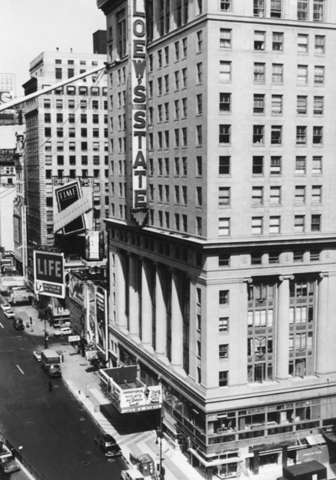
This detail from a postcard photograph shows the relationship between the Astor Roof sign and the windows of the Loew’s Building’s 8th floor, which is the floor just above the prominent ledge even with the bottom of the Loew’s State theater sign. This pre-war view includes signs for Chevrolet, Planters Peanuts, and Coca-Cola, which by 1945 had been replaced by signs for Kinsey Whiskey, Ruppert Beer, and Pepsi-Cola. The enormous sign at the right advertised Wrigley’s Spearmint in the pre-war days and Schlitz Beer in 1945. Credit: Collection of Donald Olson -
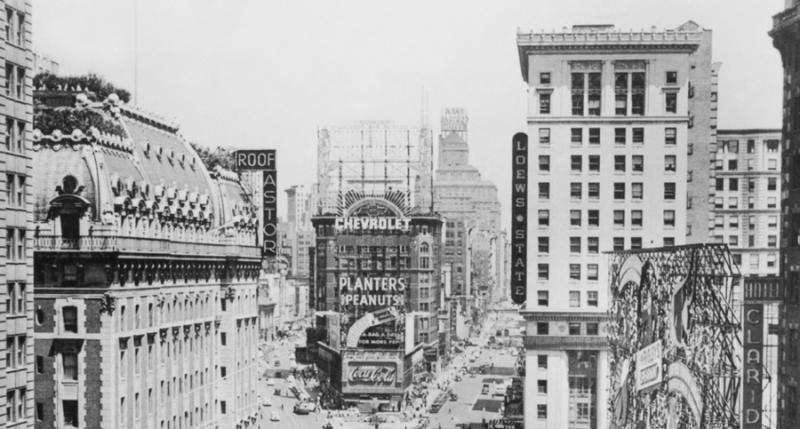
This detail from a postcard photograph shows the relationship between the Astor Roof sign and the windows of the Loew’s Building’s 8th floor, which is the floor just above the prominent ledge even with the bottom of the Loew’s State theater sign. This pre-war view includes signs for Chevrolet, Planters Peanuts, and Coca-Cola, which by 1945 had been replaced by signs for Kinsey Whiskey, Ruppert Beer, and Pepsi-Cola. The enormous sign at the right advertised Wrigley’s Spearmint in the pre-war days and Schlitz Beer in 1945. Credit: Collection of Donald Olson
Provided by Texas State University





















